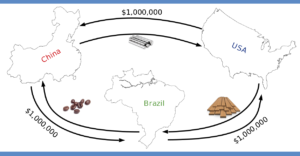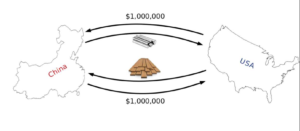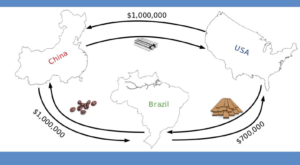“Finn” e-mailed me to ask for an explanation of why, in a world of more than two countries, all talk of bilateral trade accounts – all talk of bilateral trade deficits and of bilateral trade surpluses – is nonsense.
Take a look at this visual.

Suppose that the world has only three countries: Brazil, China, and the United States. Suppose also that the only international transactions that occur in 2019 are the transactions shown in this visual.
Notice that the value of each country’s exports equals the value of its imports. With the rest of the world, each country’s current account is balanced. But each country has a bilateral trade deficit of $1,000,000 with another country and a bilateral trade surplus of $1,000,000 with another country. (For example, America here has a $1,000,000 trade deficit with China, and a $1,000,000 trade surplus with Brazil.
Of what significance is this $1,000,000 U.S. trade deficit with China? Answer: none.
If you still don’t see its insignificance, imagine that the Chinese, upon receiving $1,000,000 from Americans who bought Chinese steel, spend that $1,000,000 not on Brazilian coffee but, rather, on American lumber.

In this alternative case, nothing of any economic significance differs, for Americans, from the first case: Americans still buy $1,000,000 of steel from foreigners and sell $1,000,000 of lumber to foreigners. But only in the second case is there no U.S. trade deficit with China.
Does it matter that the nationality of the lumber buyers are Chinese rather than (as in the previous example) Brazilian? Not at all. Yet if you take seriously the fears and anxieties expressed by those who worry about, say, the so-called U.S. trade deficit with China, apparently the nationality of the lumber buyers does somehow matter.
In each of the above examples, the U.S. has a “balanced” current account – that is, loosely speaking, neither a trade deficit nor a trade surplus. Ditto for each of the other countries.
Now consider this third example:

Here, the U.S. has a $300,000 trade deficit with the rest of the world, and a $300,000 capital-account surplus with the rest of the world. (The $300,000 returns to the U.S., but it does so on the capital account rather than on the current account. And its return on the capital account – as investment in the U.S. – creates jobs no less than it would had this sum returned instead on the current account – that is, as demand for U.S. exports.)
In addition, the U.S. has a $1,000,000 so-called and completely economically meaningless trade deficit with China, along with a $700,000 so-called and completely economically meaningless trade surplus with Brazil.
But as can be seen in this example, all of the investment flowing into the U.S. from outside of the U.S. is from Brazil. None of this investment is from China, despite the fact that China is the only country with which the U.S. has a bilateral trade deficit.
The point here is that, in a world of more than two countries, the best way to talk and write about trade is that residents of the home country trade with foreigners, as well as invest abroad and receive investment from abroad. Singling out specific countries with which trade and other commercial exchanges occur risks enormous misunderstanding – misunderstanding that protectionists never hesitate to turn to their advantage when attempting to drum up public support for tariffs and other trade restrictions.
…..
I thank my son, Thomas, for making the above visuals.



